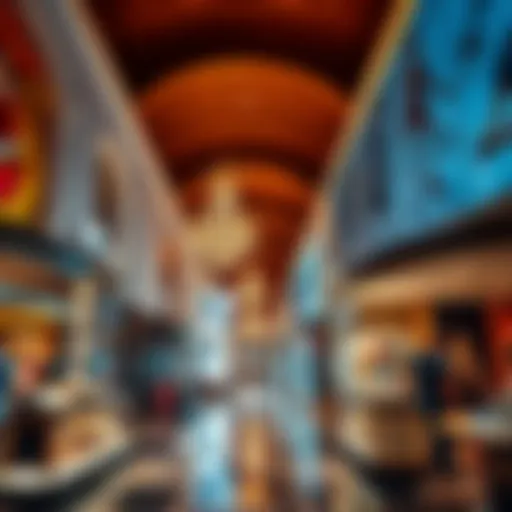Explore Dubai's Premier Markets: A Detailed Guide
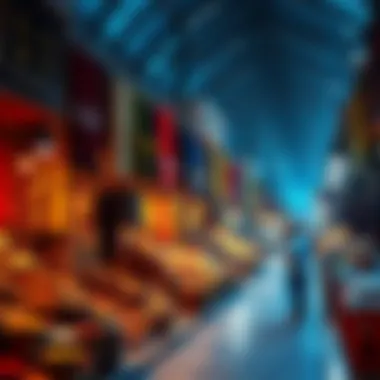
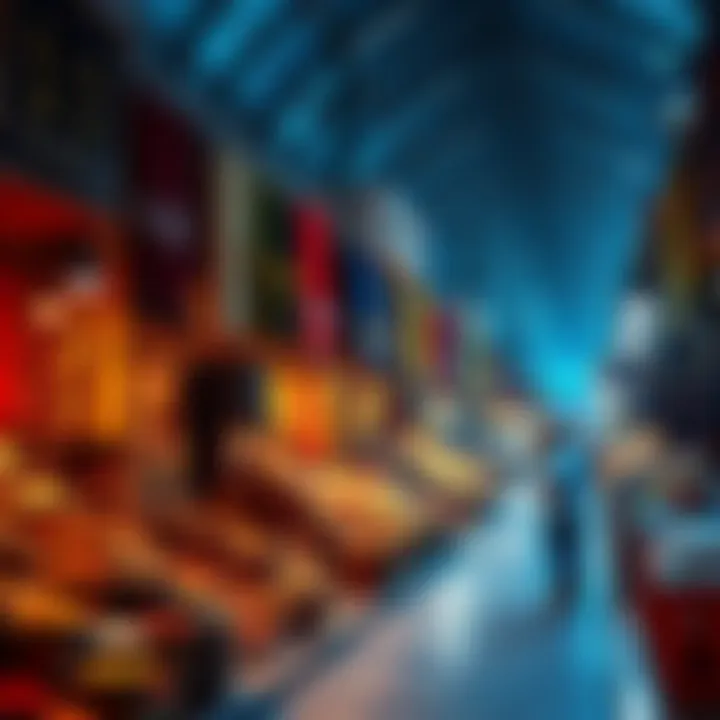
Intro
Dubai's markets are not merely shopping venues; they're a vibrant tapestry woven with traditions, culture, and modern needs. The city boasts a unique blend of ancient souks and contemporary malls, reflecting its evolution over the years. As the retail landscape shifts, understanding these markets is essential not just for consumers looking for the best deals, but also for investors keen on capitalizing on the growth opportunities.
In this article, we embark on a journey through Dubai's premier markets. We'll explore their distinctive features, historical context, and current trends that shape the retail environment. Each market has its own story, providing insights not only into shopping preferences but also into the cultural identity of Dubai.
Let’s take a closer look at the current market trends that make these venues bustling hubs of activity.
Market Trends
Current Real Estate Landscape
As we delve deeper into the retail ardour of Dubai, it is essential to contextualize it within its real estate framework. The current landscape reflects a dynamic environment, influenced significantly by both local and international factors. The development of new commercial spaces and accessibility improvements has sparked notable interest among retail investors.
Given the significant influx of tourists and the burgeoning expat population, demand for retail real estate remains robust. Investors are gradually recognizing that locations such as Dubai Mall and Mall of the Emirates are not just shopping destinations but potential gold mines, given their foot traffic and luxury offerings.
Many new retail spaces are popping up in areas like Dubai Marina and Jumeirah, catering to high-end shopping experiences and fostering a community feel. The integration of mixed-use developments allows shoppers to enjoy not only retail but also dining and leisure activities all within a single precinct.
"Dubai’s market landscape is not static; it’s a vibrant ecosystem that adapts to the needs of its residents and tourists alike."
Property Price Trends
When it comes to property prices, understanding the trends can reveal much about consumer sentiment and investment potential. Currently, prime retail properties in established areas show a steady increase in rental values, driven by high demand. However, lesser-known local markets are catching up, with prices gradually rising as their popularity grows.
Many trends indicate a shift towards more affordable retail spaces in suburban areas, which cater specifically to the local populace. This transformation is vital as it bridges the gap between luxury and accessible shopping options, ensuring everyone has a piece of Dubai's economic pie.
In particular, Mirdif City Centre and Dubai Festival City have become noteworthy for their diverse retail options catering to various demographics. Such developments are fostering community engagement and a vibrant shopping culture that aligns with the evolving lifestyle choices of Dubai's residents.
Ultimately, understanding these market trends offers invaluable insights to investors looking to navigate the complexities of Dubai’s retail landscape and seize the right opportunities.
Investment Opportunities
High-Return Areas
Identifying areas with high-return investment potential is crucial for success in Dubai’s competitive market. Several neighborhoods stand out due to their strategic positioning and current development initiatives.
- Dubai Marina: Known for its scenic views and luxurious lifestyle options, this area remains a prime location for high-end retail spaces.
- Downtown Dubai: Home to the world-renowned Burj Khalifa, this area attracts millions of tourists and offers unparalleled retail opportunities.
- Al Qusais: Don’t overlook this emerging area, where the prices are still reasonable, and the potential for growth is significant as new developments emerge.
Investors can enhance their portfolios by focusing on these key areas that promise not only high returns but also sustained interest over time, driven by Dubai’s continued growth.
Upcoming Developments
With its ever-evolving landscape, Dubai continuously reveals new projects championing innovation. The upcoming Dubai Creek Harbour promises a strategic retail hub that is poised to attract both residents and tourists alike, aiming to redefine the shopping experience in Dubai.
Furthermore, the recently announced Mohammed bin Rashid City is expected to enhance the retail landscape, offering a combination of residential spaces and commercial outlets to cater to a diverse shopping populace.
Monitoring these developments is essential for savvy investors hoping to stay ahead in a rapidly changing market that thrives on new ideas and experiences. The foresight will not only lead to investments in high-return areas but also capitalize on the cultural significance that Dubai's markets inherently possess as they adapt to the aspirations of their clientele.
Overview of Dubai's Market Landscape
Dubai's market landscape is a dazzling reflection of its rich history and forward-thinking spirit. Understanding this topic is vital for anyone keen on navigating the economic climate here. The blend of traditional and modern markets symbolizes Dubai's evolution from a humble trading post to a global hub for commerce and tourism. This unique mixture not only appeals to tourists but also attracts investors looking to capitalize on emerging opportunities.
The growth of Dubai’s markets is shaped by several key factors. First, the accessibility of resources and significant foreign investments has fostered a thriving retail environment. Second, the cultural diversity within the city presents a robust consumer base, eager for unique shopping experiences ranging from souks to high-end malls.
By delving into the characteristics of these markets, readers can appreciate the potential for success in Dubai’s multifaceted economy. The understanding of historical context helps frame the present, while awareness of current trends provides insight into future developments. In sum, a grasp of Dubai's market landscape reveals possibilities for growth and prosperity that can benefit both individual consumers and corporate entities alike.
Historical Context
Evolution of Trade in Dubai
The evolution of trade in Dubai traces back centuries when it was primarily known for its pearl diving and fishing industries. Over time, trade flourished, with the establishment of merchant routes that attracted global traders. What makes this topic interesting is the transformation of Dubai from a local trading hub into an international marketplace. The strategic location along trade routes allowed merchants from Asia, Europe, and Africa to converge in Dubai, promoting extensive exchanges of goods and cultures.
Today, Dubai stands as a prominent center for various industries, driven by its commitment to innovation and infrastructure development. The historical aspect illustrates not just the growth of trade, but also the emergence of Dubai as a recognized player on the world stage. This evolution is beneficial, making it clear that understanding past trends can inform future investments.
Impact of Globalization
Globalization has profoundly impacted Dubai's trade dynamics, contributing to its identity as a cosmopolitan market. With free zones and trade agreements, Dubai has become a gateway for businesses aiming to enter the Middle Eastern market. This characteristic of globalization enhances connectivity, allowing products and cultures to flow more freely.
A unique feature is the way Dubai has embraced technology to streamline trade processes. Online platforms and logistic hubs facilitate trade operations, reducing time and costs for businesses. This makes Dubai a competitive choice for commercial investments, albeit also exposing local markets to global fluctuations and competition. Understanding this balance is essential for anyone looking to engage with the local economy.
Cultural Integration
Cultural integration in Dubai is not just a backdrop; it's the vibrant framework that supports its market landscape. The city is a melting pot, where Eastern and Western influences create a bespoke consumer culture. This unique aspect attracts tourists and expats, who contribute to an ever-evolving market.
Moreover, the integration of diverse cultural practices influences products and services, thereby enhancing the retail experience. For instance, local festivities, like Ramadan, see a surge in demand for specific goods and services, offering businesses insights into consumer behavior. This adaptability works to create a business-friendly environment that can be beneficial for investors seeking to reach a diverse clientele.
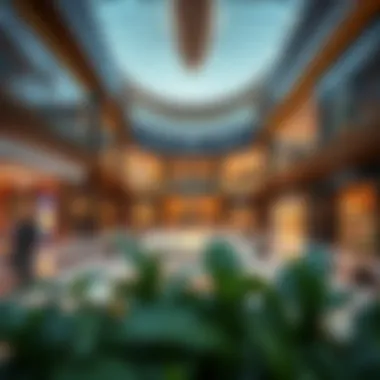
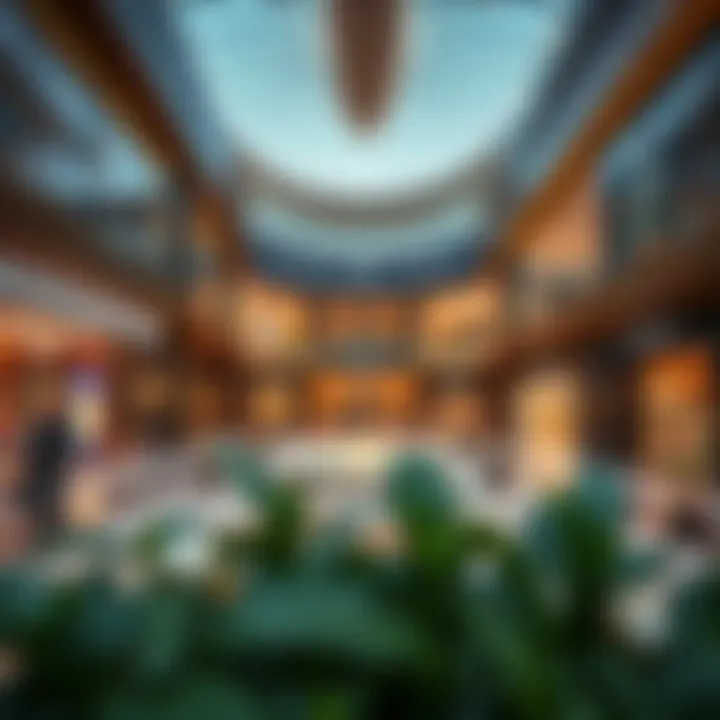
Current Economic Climate
Key Economic Indicators
Analyzing the key economic indicators provides a snapshot of Dubai's overall economic health. Metrics such as Gross Domestic Product (GDP), inflation rates, and unemployment levels offer insights into market stability and growth prospects. Particularly, the resilience displayed by the economy in the face of global challenges showcases its potential.
A noteworthy characteristic of these indicators is their mixed signals; while tourism and retail sectors are on the rise, challenges remain, such as regional instabilities. Hence, understanding these elements is crucial for making informed investment decisions.
Effect of Tourism
Tourism plays a significant role in bolstering Dubai's economic landscape. The influx of tourists contributes immensely to various sectors, particularly retail. Hosting grand events, such as the Dubai Shopping Festival, not only enhances visitor numbers but also drives spending across different markets.
This aspect underlines the importance of a vibrant tourism strategy that aligns with broader economic objectives. The benefit is clear: a thriving tourism sector can lead to increased demand for local products, providing a lucrative avenue for businesses.
Growth of E-commerce
E-commerce has emerged as a significant player in Dubai's economy, promising substantial growth in the coming years. The rise of online shopping platforms like Noon and Souq has reshaped consumer behavior, offering convenience and a wider range of products.
A distinct feature of this phenomenon is the increased emphasis on digital payment systems, which fosters smoother transactions. However, the challenge lies in forging trust among customers who may still prefer traditional shopping. Thus, while the prospects of e-commerce are bright, businesses must navigate potential hurdles to fully harness this growth.
In summary, understanding the historical context and current economic climate of Dubai's marketplace is essential for investors and consumers alike, allowing them to identify opportunities and challenge that characterize this dynamic environment.
Traditional Markets: Souks of Dubai
When one thinks of Dubai, the mind often wanders to skyscrapers and glimmering malls. However, to truly grasp the essence of this city, one must delve into its traditional markets, known as souks. These bustling hubs are not just places for commerce; they are vibrant communities where culture, history, and daily life intertwine. The souks offer a unique glimpse into the heritage of Dubai, revealing how trade has shaped the city over centuries. They serve as a reminder that while the skyline may be modern, the roots of Dubai lie deep in its traditions.
Gold Souk
Significance of Gold Trading
Gold holds a crucial place in Dubai's economy and culture. The Gold Souk is a treasure trove, often showcasing over 300 retailers. Visitors from around the world flock here, drawn by competitive prices and an unmatched variety. The significance is not merely economic; gold is often a symbol of wealth and status among locals, intertwining the intricate cultural tapestry of the UAE. This market stands as a beacon for investors looking to understand the influence of precious metals in the region.
Consumer Experience
Wandering through the Gold Souk is akin to stepping into a glimmering fairy tale. The warm glow of gold adornments is palpable, and the atmosphere is electric with the buzz of negotiation and discovery. Shops display an extensive array of items, from intricately designed jewelry to simple yet elegant pieces. Shoppers often enjoy a personalized experience, allowing them not just to purchase but to engage in a dialogue about the craftsmanship involved. Yet, the charm can also come with challenges: the vast options can overwhelm, requiring a degree of patience and discernment.
Pricing Trends
When discussing pricing trends, the Gold Souk is a prime example where market forces influence rates daily. Prices fluctuate based on international gold rates, as well as seasonal demand spikes, particularly during festivals and weddings when gold purchases peak. Those looking for deals might find the souks provide an edge, as prices here are often lower than in high-end malls, making it an appealing option for both consumers and investors who are vigilant about market dynamics.
Spice Souk
Varieties of Spices
The Spice Souk is a sensory overload, where vivid colors and tantalizing aromas fill the air. It showcases an astonishing variety of spices, from saffron to sumac, contributing to Dubai's reputation as a culinary melting pot. Each spice tells a story of the region’s trade routes and cultural exchanges. By exploring this souk, visitors not only enhance their culinary knowledge but also appreciate the community's connection to global food traditions.
Cultural Importance
Spices are more than mere ingredients; they are part of cultural rituals and local traditions. The Spice Souk embodies the spirit of hospitality found in Emirati culture. Here, spices play a starring role in many dishes. The communal aspect is almost tangible, as vendors often offer samples, inviting passersby to taste before they buy. However, the reliance on such markets for authentic ingredients also raises questions about sustainability and sourcing, given the global push for ethical trade.
Sampling and Purchasing Tips
Navigating the Spice Souk can be a delightful experience with the right approach. Engaging with vendors often leads to a deeper understanding of each spice's origin and use. Visitors should feel free to sample products; it’s not just welcomed but encouraged. One notable tip is to bargain politely, as haggling is part of the shopping culture here. However, newcomers often find it tricky to strike a balance between cultural respect and securing a favorable price. It's wise to observe first and then join the conversation.
Textile Souk
Fabric Types and Styles
The Textile Souk is a fascinating blend of colors, patterns, and textures, offering everything from silks to cottons. This market is not only a retail space but also a gallery showcasing the craftsmanship from various cultures. Textiles here reflect the rich history of trade in Dubai, with influences from India, Iran, and beyond. The choice available is staggering, catering to both casual shoppers looking for a casual garment and tailors seeking high-quality fabrics for bespoke creations.
Art of Bargaining
Bargaining in the Textile Souk is not merely transactional; it’s an essential social skill. Vendors expect customers to negotiate. It’s seen as an art form that builds relationships rather than just closing deals. A strategy often practiced includes starting with a low offer and gradually moving upward, while keeping the mood friendly. However, willy-nilly bargaining may result in lost opportunities to secure genuinely good finds, so newcomers should approach with strategy and respect.
Local and International Influence
The Textile Souk embodies a blend of local and international influence, showcasing the UAE's diverse cultural landscape. Local artisans often collaborate with international designers, creating unique hybrid products that catch the eye of both residents and tourists alike. This market reflects how Dubai serves as a crossroads of cultures, where traditional techniques meet contemporary design trends. However, with this mix can come challenges, such as ensuring quality and origin given the variety of sources.
Modern Shopping Destinations
Dubai is not just known for its traditional markets but also shines through its modern shopping centers, which offer a unique blend of luxury, culture, and convenience. These commercial hubs play a crucial role in the retail landscape by attracting tourists and locals alike. They’re remarkable not only for the sheer scale of retail options but also for their entertainment, dining, and leisure facilities. In this section, we’ll delve into the most prominent shopping destinations in Dubai and highlight their various offerings and significance.
Dubai Mall
Features and Attractions
The Dubai Mall stands out on the global stage, boasting not only an extensive array of shops but also unique attractions such as the Dubai Aquarium and Underwater Zoo. The sheer size of the mall makes it a destination unto itself. One of the key features is the Dubai Fountain; it performs breathtaking water shows, which can leave visitors in awe. Those elements contribute not only to shopping but also create an immersive experience, ensuring that visitors don’t just grab a bag and dash. The variety of features makes it a fabulous choice for shoppers and tourists alike.
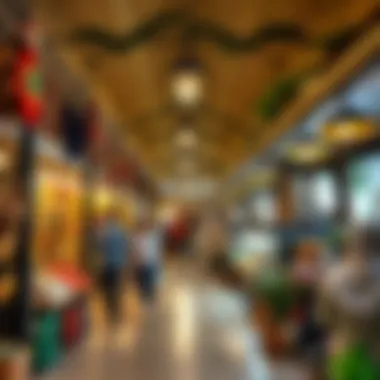
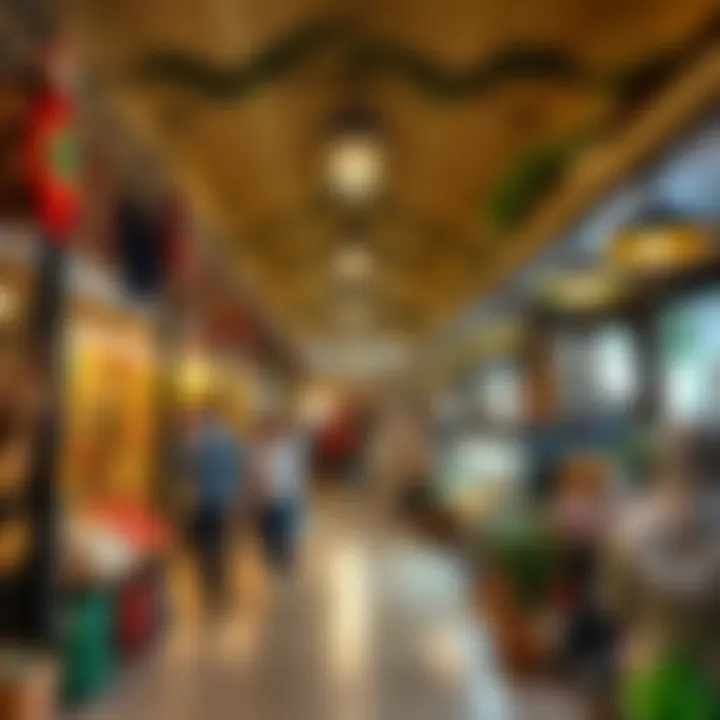
Retail Diversity
Another striking aspect of the Dubai Mall is its retail diversity. Housing over 1,200 retail outlets, one can find everything from high-street fashion to luxury brands. It creates an environment where shoppers can easily compare styles and prices, ensuring that whatever the budget — there’s something for everyone. This retail mix caters to both luxury seekers and everyday consumers, proving beneficial to a broad audience. And that’s what makes shopping in this mall so popular; the ability to wander from high-end boutiques to more affordable shops all under one roof.
Visitor Demographics
Variable visitor demographics contribute significantly to the mall's vibrancy. Each year, millions flock to this shopping haven, including tourists from all corners of the globe and locals looking for a day out. The mall is designed to accommodate families, young adults, and senior citizens alike, facilitating a broad cross-section of society. This aspect means that the offerings are continuously tailored to appeal to varied tastes and preferences. It ensures a more inclusive shopping environment, enhancing the overall reputation of the mall.
Mall of the Emirates
Ski Dubai Experience
One of the standout features of the Mall of the Emirates is Ski Dubai, an indoor ski resort. This unique experience transports visitors from the desert heat to a winter wonderland, complete with real snow and thrilling slopes. It’s a remarkable offering that distinguishes the mall from others in the city. Not many malls can claim to have a skiing complex; this brings families and adventure-seekers together under one roof, keeping everyone entertained.
High-End Retailers
The Mall of the Emirates is equally renowned for its high-end retailers, housing names recognizable worldwide, such as Chanel, Gucci, and Louis Vuitton. The presence of these luxury brands distinguishes it from other malls and satisfies the appetite for opulence. Shoppers seeking exclusive items can find them here, offering a unique shopping experience that appeals specifically to the luxury market. This distinction effectively places the mall as a top choice for a high-end shopping excursion.
Family Entertainment Options
Families visiting this mall are in for a treat as it hosts various entertainment options beyond shopping. From an impressive movie theatre to a family-friendly arcade, there’s something to keep every member occupied, and that’s essential to enhancing the shopping experience. Ensuring that families can enjoy a day out while still indulging in retail therapy makes the mall stand out, enhancing its appeal.
Ibn Battuta Mall
Architectural Themes
Ibn Battuta Mall offers a distinctive shopping experience with its architectural themes inspired by the travels of the famed explorer Ibn Battuta. This thematic design draws visitors into a more culturally-rich experience. Each section of the mall represents a different region, making the atmosphere unique. The architectural aesthetics bring an educational element, immersing shoppers in history and culture while they browse their favorite stores.
Shopping Experience
Shoppers here can enjoy a more leisurely experience than in some of the larger malls. With fewer crowds and a more open layout, the atmosphere promotes a relaxed environment. Visitors can take their time exploring shops without feeling rushed, which can often be the case in busier malls. This is particularly appealing to those who want a meaningful shopping experience that goes beyond transaction; it's all about the journey.
Dining Opportunities
Dining options at Ibn Battuta Mall are both diverse and abundant. From international cuisines to local specialties, there's a little something for everyone. Whether it’s a quick bite or an upscale dining experience, the mall caters to varied culinary tastes designed to complement the shopping experience. This abundance of options enhances the overall appeal of a visit, making it not just about shopping but also savoring diverse flavors, proving advantageous for all diners.
Specialty Markets and Pop-Ups
Specialty markets and pop-ups in Dubai embody the essence of local flair and innovation. They serve as vibrant spaces that foster a sense of community and offer unique shopping experiences that stand apart from the mainstream retail avenues. With their distinct characteristics, they contribute significantly to both the local economy and the cultural landscape of the city. These markets not only spotlight the crafts and flavors of local artisans but also entice shoppers with their ever-changing offerings, making them an essential part of Dubai's marketplace.
Artisan Markets
Local Artisans and Crafts
Local artisans and their crafts provide a window into Dubai’s rich cultural heritage. These artisans bring their skills, honed through generations, to create items that are not just products but stories, blending tradition with creativity. From handmade pottery to intricate jewelry, each piece often reflects a unique perspective and history. The appeal of local crafts lies in their authenticity and the personal touch, which mass-produced items usually lack. For shoppers looking for something singular and meaningful, supporting local artisans becomes a priority. The unique aspect here is how these crafts can shift the idea of consumerism; instead of simply purchasing items, buyers engage with a narrative and a culture, making it a beneficial choice in every sense.
Supporting Small Businesses
Supporting small businesses through specialty markets cultivates local entrepreneurship and strengthens the community. When consumers choose to shop at these venues, they're investing in the livelihoods of individual craftsmen and women, thus enabling them to thrive. This has a ripple effect; as small businesses grow, they often contribute to local developmental efforts and create jobs, which can uplift the entire locality. The charm of these markets is their variety—one can discover everything from exotic spices to handwoven textiles, making them a favored spot for those keen on diverse offerings. However, buyers must be aware that such markets can sometimes lack the consistency found in large retailers, as supply can fluctuate with demand.
Market Locations
The locations of these specialty markets are strategic; often nestled in the heart of popular tourist spots or upcoming neighborhoods, they become accessible to a wide audience. The distinctive charm of these locations often enhances the shopping experience with a backdrop of bustling city life and cultural exchanges. Take, for instance, the artistic vibe of Al Quoz, where many artisan markets set up shop. Such locations add vibrancy and character, allowing shoppers to immerse themselves fully in Dubai’s dynamic atmosphere. However, it’s also crucial to realize that these markets might face seasonal variations in patronage, influenced by both local and tourist visiting patterns.
Food Markets
Unique Culinary Experiences
Food markets in Dubai present an eclectic palette of flavors that go beyond typical dining experiences. Visitors can indulge in a smorgasbord of local dishes and international cuisines, reflecting the city’s melting pot of cultures. These markets often host food stalls that combine traditional recipes with modern twists, inviting food lovers to explore and taste something extraordinary. The advantage here is not just the variety, but also the opportunity to interact with chefs and vendors, gaining insights into the food’s origins. However, it’s essential to manage expectations, as some food markets may be crowded, especially during peak visiting seasons.
Health and Wellness Trends
As health consciousness grows, food markets in Dubai are increasingly catering to health and wellness trends. Shoppers can find an array of organic produce, gluten-free options, and nutritious snacks, appealing particularly to health-focused consumers. This adaptation reflects a broader shift towards healthier living within the community. Here, the noteworthy aspect is the integration of wellness into everyday living, making it easier for individuals to make informed choices. However, one may notice a premium pricing on these health-oriented products, which might not fit every budget.
Community Events
Community events often play a significant role in boosting food markets. These gatherings—be it food festivals, cooking classes, or cultural celebrations—transform simple market visits into rich social experiences. Such events encourage community spirit and foster connections between vendors and consumers. They often highlight local culinary talents and create a platform for interaction among attendees. While these events can enhance engagement and enjoyment, they can also lead to increased foot traffic, which sometimes poses challenges for vendors trying to manage high demand alongside product availability.
Impact of Cultural Events on Shopping
Cultural events in Dubai significantly fun and influence the shopping landscape, making them essential aspects of the city's retail scene. Understanding this impact helps investors, homeowners, and business analysts gauge market trends and consumer behavior. The intertwining of culture and commerce creates a bustling environment, where shopping becomes more than just a transaction; it is an experience woven into Dubai's rich tapestry.
Dubai Shopping Festival
Sales and Promotions
The Dubai Shopping Festival is synonymous with sales and promotions that offer consumers a chance to snag deals like never before. This celebration attracts not only locals but tourists pouring in from across the globe. The allure of discounts—often reaching up to 75% off—draws shoppers looking for everything from luxury goods to everyday essentials.

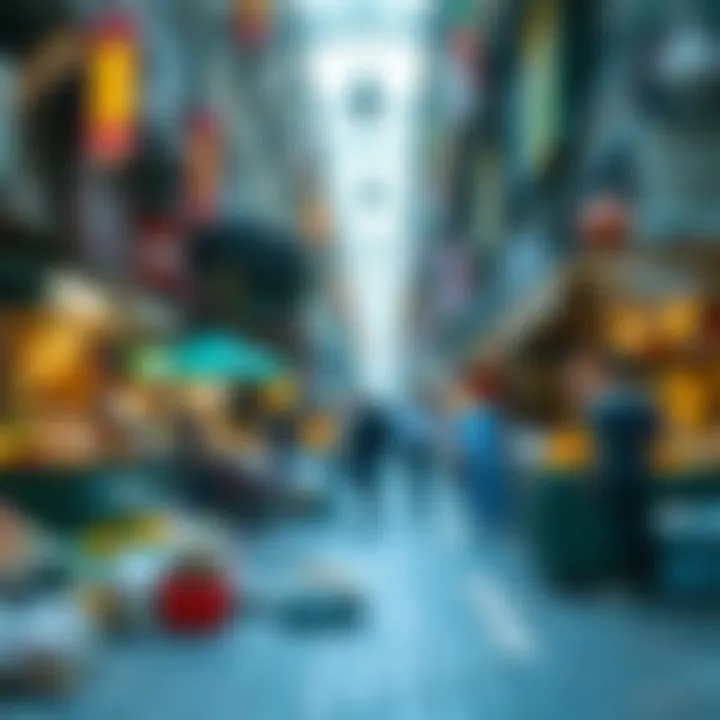
This festival showcases vendors' creativity, as they craft promotions that resonate with the diverse demographic of Dubai. Notable characteristic of the sales is their time-limited nature; the countdown ticks down as shoppers rush to make the most of their visit. Such offers not only boost sales but also position Dubai as a shopping haven in the Middle East.
But there is a flip side; some consumers may find the quantity of options overwhelming, leading to decision fatigue. Still, the overall effect of these promotional strategies remains largely positive.
Cultural Activities
Cultural activities during this festival contribute immensely to the shopping experience. Besides deals, visitors get to immerse themselves in traditional performances, art exhibitions, and culinary events. These activities create a vibrant atmosphere, where the joy of shopping is enhanced by rich cultural displays.
Key characteristic of cultural activities is their ability to foster community engagement. Locals, expatriates, and tourists gather to enjoy music, dance, and food, knitting a rich cultural fabric around shopping events. However, balancing logistical challenges with the need for crowd management can be daunting for organizers. Yet, the cultural infusion is what makes the festival stand out, imprinting a unique memory for every visitor.
Visitor Engagement
Visitor engagement during the Dubai Shopping Festival is remarkable, mainly due to various interactive experiences available. Shoppers find opportunities to participate in competitions, witness fashion shows, and enjoy workshops, making it a thoroughly engaging outing. The emphasis on interaction transforms the normally transactional process into an enjoyable experience.
One might argue that even with all the excitement, sustaining visitor engagement throughout the event can be tricky. Nevertheless, the unique features of engagement that can include social media integration or loyalty programs add value, keeping the buzz alive. In making every participant feel involved, the festival not only boosts sales but also solidifies Dubai's reputation as a global shopping destination.
Ramadan and Eid Shopping
Religious Significance
Ramadan and Eid significantly shape shopping habits in Dubai. For many, shopping is not just an act; it’s an essential part of the religious experience. During Ramadan, the act of giving becomes a key focus, with many individuals purchasing gifts and charitable donations in preparation for Eid.
Religious significance dictates a unique shopping rhythm observed in the city. Retailers adapt their hours to accommodate those who shop after iftar, adding a festive atmosphere to the malls and stores. The period is characterized by an increased focus on modest fashion, gourmet foods, and home decor, appealing to the cultural sensitivities of the time.
This strong tie between religion and commerce enhances the shopping experience for locals and visitors alike. The challenge, however, remains in finding the balance between maintaining spiritual practices and the consumerism pressure that sometimes emerges during such significant times.
Discount Tendencies
During the Ramadan and Eid seasons, many retailers offer special discounts. These discounts are particularly attractive to families looking to celebrate the holidays without breaking the bank. The key characteristic of these discount tendencies is their strategic timing; retailers often launch promotions just before Eid, ensuring shoppers can deck out their homes or buy gifts affordably.
These discounts create a buzz, drawing shoppers keen on saving while honoring their traditions. However, it's crucial for retailers to maintain profit margins, which might be a balancing act against the sheer volume of markdowns expected.
Product Availability
Product availability during the Ramadan and Eid shopping seasons reflects not only consumer demand but also cultural shifts. Many retailers stock products specific to the festivities—like dates and special sweets—catering to both local tastes and the influx of international visitors. It's a unique time when the sheer variety can be overwhelming, but also celebratory.
The unique feature of this period is the vibrant assortment of products available that reflects Dubai's cosmopolitan nature. Consumers can find everything from traditional attire to modern gadgets, giving them a wide array of choices. However, managing inventory to meet this heightened demand can lead retailers to face challenges. Keeping shelves stocked with the right mix of products is crucial, as the simplest misjudgment can lead to empty shelves and dissatisfied customers.
Future Trends in Dubai's Retail Sector
The retail landscape in Dubai is continuously evolving, shaped by both consumer expectations and technological advancements. Understanding the future trends in Dubai's retail sector is crucial for investors and homeowners alike, as it provides insights into where opportunities may arise and how the market will adapt to changing demands. As we explore this topic, we will highlight key areas such as technological innovations and sustainability, which are both set to influence the retail market in substantial ways. The resulting shifts will affect everything from the types of products offered to the methods through which consumers engage with brands.
Technological Innovations
Online Shopping Platforms
In today's digital age, online shopping platforms are not just an afterthought but a vital pillar of retail strategy. The growth of e-commerce in Dubai is noteworthy; it allows consumers to shop from the comfort of their homes while providing a vast array of products. One major benefit of these platforms is their accessibility. They connect buyers and sellers across various demographics, breaking down barriers that once limited participation in local markets. Moreover, platforms like Souq.com, now integrated into Amazon, have become household names, showcasing the importance of global connectivity in localized retail experiences.
However, while the convenience is commendable, shoppers should be cautious of the increasing competition that leads to price wars, which can sometimes undermine small businesses.
Augmented Reality Integration
Augmented Reality (AR) is carving out a niche in the retail sector by creating immersive shopping experiences. Its use ranges from virtual try-ons in fashion to overlaying product information while shopping in-store. For instance, AR applications enable customers to visualize furniture in their homes before making a purchase decision. This capability not only enhances customer engagement but also reduces the likelihood of returns—an ever-present concern in retail.
However, not all shops have adopted this technology. The high cost of implementation and ongoing maintenance could pose challenges for smaller retailers. Still, for those who embrace it, AR offers a unique selling proposition that can distinguish them from competitors.
Customer Experience Enhancements
Enhancing customer experience has become the mantra for retailers seeking to thrive in a competitive environment. Strategies that focus on personalized marketing, such as tailored recommendations and targeted promotions, are increasingly crucial. Retailers are harnessing data analytics to gauge customer behavior and preferences, thereby fine-tuning their offerings.
For example, stores that incorporate loyalty programs often see better customer retention. These enhancements increase repeat purchases and build brand loyalty, which is invaluable in today's market. Yet, there are potential pitfalls; over-personalization can sometimes come across as intrusive, prompting customers to feel as if their privacy is being compromised.
Sustainability in Retail
Eco-Friendly Products
The shift towards eco-friendly products cannot be overlooked. As consumers become more environmentally conscious, there is a growing demand for sustainable goods. Retailers that adopt eco-friendly practices often see a boost in customer loyalty. Many consumers are willing to pay a premium for products that align with their values, viewing their purchases as a form of political expression. For instance, brands that emphasize organic ingredients or utilize sustainable packaging are increasingly popular.
However, this trend also presents challenges; the sourcing of sustainable materials can sometimes lead to higher costs, affecting margins. Yet, embracing sustainability is not merely altruistic—it can also be a powerful differentiator in a crowded market.
Corporate Responsibility
Corporate responsibility is a vital piece of the retail puzzle. Businesses are expected to hold themselves accountable for their impact on society, whether through fair treatment of workers, ethical sourcing of materials, or community engagement. Companies that prioritize corporate responsibility often find themselves at a competitive advantage. Customers appreciate transparency and expect brands to contribute positively to their communities. This can manifest in various ways, such as through charitable initiatives or local sourcing strategies.
However, the risk of scrutiny is high; companies that fail to live up to their corporate social commitments can face backlash, which can lose them customer trust and significantly alter market perception.
Consumer Awareness
Finally, heightened consumer awareness shapes the future of the retail sector. Shoppers today are more informed than ever, thanks to access to information online. They are keen on understanding product origins, ethical practices, and sustainability measures before making purchases. Retailers are adapting to this trend by being more transparent in their offerings and marketing strategies. Engaging consumers not only through ads but also through storytelling can foster a deeper connection.
On the flip side, the need to remain transparent can be daunting for businesses. Misinformation can spread quickly online, and negative publicity can have lasting effects. Ultimately, aligning product offerings with informed consumer values is essential in maintaining relevance.
The future trends in Dubai's retail sector underscore the importance of adaptation. Those who embrace innovation and sustainability while being transparent about their practices are likely to find themselves leading the pack.















